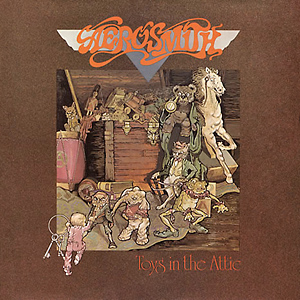
Toys in the Attic is an undeniably rock ‘n’ roll album. Still Aerosmith’s most acclaimed record, it launched the Boston rockstars to new heights in 1975. Steven Tyler is a rock vocalist through and through, elevated by technically challenging and emotionally charged performances by guitarists Joe Perry and Brad Whitford.
It’s not just an album for the lyricist or the vocalist, but one for the whole musician. By the recording of their third album, every member of Aerosmith was so mechanically skilled that, mixed with their raw talent, they were a powerhouse of a band. Every instrumental part of this album is complex, engaging and just plain good music.
Jack Douglas’s production on this record brings it from great to exceptional. For one, it’s amazingly clean; nothing about Toys in the Attic sounds like it was made 50 years ago. It was produced so intentionally, from the carefully arranged stereo sound to instrumentals that make you really feel the music. The outro of “Round and Round” is a prime example of the careful audio engineering that went into this record; the sound starts to build up until it makes you overwhelmed and dizzy—like you’re spinning. It takes much more than musicians to make a great album.
Toys in the Attic is genre-bending but still maintains Aerosmith’s character as a band, staying just on the outskirts of genre exploration while being classic and inviting. Every song has a rocking guitar solo, but between the R&B, almost jazzy feel of “Big Ten Inch Record,” the piano in “No More No More” and the sweeping power ballad that is “You See Me Crying,” Aerosmith proves their versatility.
At its time of release, “Walk This Way” hit No. 10 on the Billboard Hot 100 and was a classic rock staple for a decade, but it would become one of the most culturally significant tracks in music history. Aerosmith’s collaboration with Run-D.M.C. on their 1986 cover brought hip-hop to the mainstream and ushered in a career revival for Aerosmith.
Toys in the Attic also delivered another one of the band’s signature songs, “Sweet Emotion.” From the opening echo of the vibraslap to the very last note, “Sweet Emotion” rocks.
I wasn’t expecting Toys in the Attic to be the masterpiece that it is because it could have been an amalgamation of forgettable songs riding on the wave of “Sweet Emotion” and “Walk This Way.” What’s special about this album is that you want to listen to every single song together, even though they could all stand alone, too. Every member of the band contributed to make such an awesome record.
It’s hard to talk about Toys in the Attic, or anything Aerosmith for that matter, without discussing Steven Tyler’s vocals. His nickname, “Demon of Screamin,” is fitting, and his vocals are a key instrument the band uses to great effect, but he really shines on “You See Me Crying.” Whether on hard rock anthems or tender ballads, Tyler always performs.
Its title track opens with energy and the last one, “You See Me Crying” expertly closes the amazing listening experience. It was exactly the ending I was waiting for throughout the record—a true power ballad to bid farewell to a phenomenal album.
In short, if you listen to Aerosmith’s Toys in the Attic, you just feel cool.
Album: Toys in the Attic
Artist: Aerosmith
Date Released: April 8, 1975
US Chart Peak: 11
Number of Weeks on Billboard Top 200 Chart: 128
Rolling Stone Top 500 Rank: 228
US Sales: 9x Platinum














